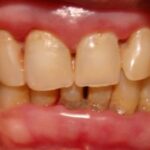
Good plaque control together with removal of supra and subgingival plaque and calculus are important elements in the successful treatment of periodontal disease. Nonsurgical treatment usually involves subgingival scaling and root planing, however, this may not remove all the calculus. Consequently, access flaps were introduced to improve the efficiency by providing direct access the root surface.
The main aim of this review was to compare access flaps and subgingival debridement in achieving probing depth reduction. A secondary aim was to assess the impact of different flap designs.
Methods
Searches were conducted in the Medline/PubMed, Cochrane Central Register of Controlled Trials and Scopus databases. Randomised controlled clinical trials (RCTs)in patients over the age of 18 with periodontitis (aggressive or chronic) comparing any access flap procedure against subgingival debridement a minimum of 10 patients per treatment group and at least 6 months follow-up were considered. Only English language publications were included. The primary outcome was probing depth (PD) reduction, clinical attachment level (CAL) change and gingival, bleeding or plaque indices were secondary outcomes. Two reviewers independently screened and selected studies and extracted data. The Cochrane risk of bias tool (RoB2) was used to assess quality. Outcomes were reported as weighted mean differences (WMDs) with 95% confidence intervals (CI) and meta-analyses conducted.
Results
- 36 publications reporting on 18 studies were included, several papers reported on different time points.
- Of the 18 RCTs 15 were of split mouth design, 3 parallel design.
- Most studies (12) performed subgingival debridement prior to surgery with controls receiving a second round of debridement. In 6 studies subgingival debridement was performed as part of the surgical phase, but not before.
- Only 1 study was considered to be at low risk of bias.
- Follow up periods ranged from: 6–156 months (mean = 41.50 ± 39.90 months).
All pockets
- irrespectively of the follow-up period access flap showed significant greater PD reduction, WMD = 0.71 mm (95%CI; 0.44 to 0.98).
Moderately deep pockets (4–6, 5–6 or 4–5 mm)
- PD reduction was significantly greater in the access flap group at the short term, WMD = 0.34 mm (95%CI; 0.21 to 0.46) [4 studies].
- the subgingival debridement group showed greater CAL gain in the short and the long terms, although this difference tended to mitigate with time
- short term; WMD = −0.34 mm (95%CI; −0.46 to −0.22) [7 studies].
- long term; WMD = −0.12 mm (95%CI; −0.22 to −0.01) [6 studies].
Deep pockets (>6 mm or ≥6 mm)
- Although both groups showed significant PD reduction in this pocket category, this reduction was significantly greater in areas receiving surgery in both the
- short term; WMD = 0.67 mm (95%CI; 0.37 to 0.97) [4 studies] and
- long term; WMD = 0.39 mm (95%CI; 0.09 to 0.70) [4 studies].
- No significant differences among groups were observed for CAL gains at the short and long term
- Harms and adverse effects related to the techniques were not reported any of the studies
- Four studies reported on pain and hypersensitivity as patient related outcomes
Conclusions
The authors concluded: –
-
AF achieved larger PD reduction when compared to subgingival debridement in initially deep pockets (>6 mm or ≥6 mm). In this pocket category, no differences were detected between treatment groups for CAL gain.
-
In moderately deep pockets (4–6, 5–6 or 4–5 mm), AF achieved greater PD reduction in the short term. However, subgingival debridement resulted in higher CAL gain.
-
In shallow pockets (1–3 or 1–4 mm), AF resulted in significantly greater clinical attachment loss.
Comments
While three major databases were searched for this review restricting inclusions to publications in English may have excluded some relevant studies. With the exception of 1 study which was conducted in private practice all the included studies were conducted in a university setting. In addition, in most studies the subgingival debridement was performed as part of the initial therapy and repeated in the assigned quadrant after randomisation and all the included studies included a strict maintenance protocol, which varied from intervals between every 2 weeks to every 6 months, including or not subgingival instrumentation. While the results demonstrated a statistically significant improvement in PD reduction between AF and subgingival debridement this may not be clinically important. It is also worth noting that with the exception of 4 studies that investigated pain and hypersensitivity no patient reported outcomes were assessed.
Links
Primary Paper
Sanz-Sánchez I, Montero E, Citterio F, Romano F, Molina A, Aimetti M. Efficacy of access flap procedures compared to subgingival debridement in the treatment of periodontitis. A systematic review and meta-analysis. J Clin Periodontol. 2020 Jul;47 Suppl 22:282-302. doi: 10.1111/jcpe.13259. PMID: 31970821.
Other references
Dental Elf – 14th Aug 2020
Picture Credits
“Periodontal Disease in 53-year old man” by Dr Parveen Chopra is licensed under CC BY-NC 2.0
